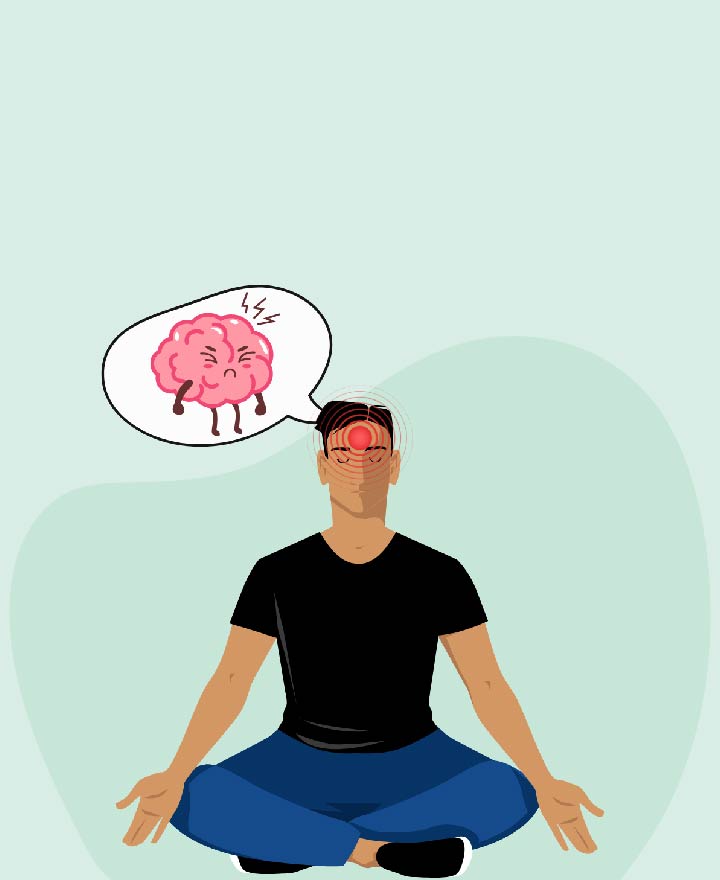

Headache From Yoga : Causes, Treatment & Prevention
Yoga is an ancient Indian practice which has a therapeutic effect on both physical and mental wellness. While the practice of yoga is often associated with pain relief, yet there are times when you might develop a headache during or after a session. This may happen for many reasons, including improper technique or preparation. Read on to know more.
Is it Common to get a Headache from Yoga?
Yoga is beneficial for headaches and migraines and as per research yoga may have the ability to relieve stress, promote better sleep, improve posture, and reduce musculoskeletal tightness.
However, despite these benefits it’s still possible to get headache while doing yoga.
Causes of Headache
Some of the most common reasons for a headache during or after a yoga session are:
1. Incorrect techniques -
Practicing yoga with the wrong technique can strain the muscles near your neck and head. This can cause a headache as well as tension and discomfort in the affected area.
2. Inversion poses -
This pose puts your head in an upside-down position which might trigger or worsen headache pain. Avoid such poses if you’re prone to headaches.
3. Improper breathing -
Improper or shallow breathing can make it difficult for oxygen to reach your muscles and brain. This, in turn, may cause a headache and muscle tension.
4. Overexertion -
While yoga is considered to be a low impact workout, if you’re new the practice then doing than what your body is capable of can lead to headache.
5. Hunger -
If you don’t eat before doing yoga, your blood glucose levels might dip and low blood glucose levels can cause a hunger headache.
6. Dehydration -
Drinking less amount of water than required is a common cause of headache.
7. Bright lights -
Bright indoor lights can trigger headache or migraine. Similarly, if you practice yoga outdoors, then bright sunlight and sun glare can cause a heat headache.
How can you prevent Headache when practicing Yoga?
Follow the tips outlined below when practicing yoga to see if they help.
• Stay Well hydrated before, during, and after.
• Eat a pre-workout snack.
• Learn the right technique.
• If prone to headache, avoid poses involving head inversion.
• Practice correct, deep, and mindful breathing.
• Start slowly and listen to your body. Do not push yourself beyond your comfort.
• Practice yoga in a room without harsh, bright lights.
Home Remedies For Treating a Headache
Few home remedies may provide you relief if you having a mild headache. They are:
1. Drink sufficient water.
2. Do breathing exercises.
3. Massaging on the temple bone and applying lavender oil can help.
4. Hot and cold compressions on your forehead or back of your neck can help reduce the headache.
If the pain doesn’t reduce, you can opt for over the counter pain relief medications.
When To See A Doctor?
In most cases, headache will go away with self care and above mentioned tips, but if not then you might need to get medical attention. Seek medical help if you experience any of the below –
• Sudden, severe & recurring headaches
• A headache that lasts for more than 72 hours or a headache after yoga injury
• Vision changes
• Vomiting
• Stiff neck
• Difficulty speaking
• Fever above 102°F
• Confusion
• Loss of consciousness
Conclusion
If you get headaches from yoga, consider your habits before and during each yoga session. You may either be dehydrated or hungry, or using improper techniques or not breathing correctly. Also, some yoga poses may make you more prone to getting a headache.
One of the important components of our overall wellness is also being financially secured. Healthcare emergencies can happen any time, but a good health insurance can protect you from such uncertain situations. To know more about it, click here
Source: Verywellmind, Serenitymindcare
Disclaimer: This blog provides general information and discussions about health and related subjects. The information and other content provided in this blog, website or in any linked materials are not intended and should not be considered, or used as a substitute for, medical advice, diagnosis or treatment. Kindly contact your Doctor before starting a new medicine or health regime.
Related Articles
7 effective yoga asanas that will help with diabetes
Iyengar Yoga and how is it beneficial
8 hasta mudra every yoga practitioner should know
Published on February 07, 2023

















 Health Insurance
Health Insurance  Travel Insurance
Travel Insurance  Car Insurance
Car Insurance  Cyber Insurance
Cyber Insurance  Critical Illness Insurance
Critical Illness Insurance
 Pet Insurance
Pet Insurance
 Bike/Two Wheeler Insurance
Bike/Two Wheeler Insurance  Home Insurance
Home Insurance  Third Party Vehicle Ins.
Third Party Vehicle Ins.  Tractor Insurance
Tractor Insurance  Goods Carrying Vehicle Ins.
Goods Carrying Vehicle Ins.  Passenger Carrying Vehicle Ins.
Passenger Carrying Vehicle Ins.  Compulsory Personal Accident Insurance
Compulsory Personal Accident Insurance  Travel Insurance
Travel Insurance  Rural
Rural